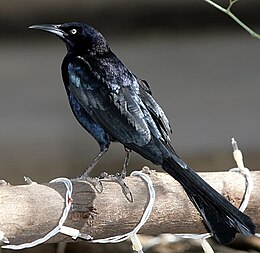Great-tailed Grackle
| Great-tailed grackle | |
|---|---|
 |
|
| Scientific classification | |
| Kingdom: | Animalia |
| Phylum: | Chordata |
| Class: | Aves |
| Order: | Passeriformes |
| Family: | Icteridae |
| Genus: | Quiscalus |
| Species: | Q. mexicanus |
| Binomial name | |
|
Quiscalus mexicanus (JF Gmelin, 1788) |
|
 |
|
| Range of Quiscalus mexicanus | |
The great-tailed grackle or Mexican grackle (Quiscalus mexicanus) is a medium-sized, highly social passerine bird native to North and South America. A member of the family Icteridae, it is one of ten extant species of grackle and is closely related to the boat-tailed grackle and the slender-billed grackle. It is sometimes erroneously referred to as a "blackbird" in the southern United States, although blackbirds belong to the genus Euphagus. Similarly, it is often called "cuervo" in areas of Mexico owing to its glossy black plumage, although it is not a member of the genus Corvus, nor even of the family Corvidae.
Great-tailed grackles are medium-sized birds (larger than starlings and smaller than crows; 38 cm (15 in)-46 cm (18 in)) with males weighing 203 g (7.2 oz)-265 g (9.3 oz) and females between 115 g (4.1 oz)-142 g (5.0 oz), and both sexes have long tails. Males are iridescent black with a purple-blue sheen on the feathers of the head and upper body, while females are brown with darker wings and tail. Adults of both sexes have bright yellow eyes, while juveniles of both sexes have brown eyes and brown plumage like females (except for streaks on the breast). Great-tailed grackles, particularly the adult males, have a keel-shaped tail that they can fold vertically by aligning the two halves.
The great-tailed grackle and boat-tailed grackle were considered the same species until genetic analyses distinguished them as two separate species.
Originally from Central and South America, great-tailed grackles expanded their breeding range by over 5500% by moving north into North America between 1880 and 2000, following urban and agricultural corridors. Their current range stretches from northwest Venezuela and western Colombia and Ecuador in the south to Minnesota in the north, to Oregon, Idaho, and California in the west, to Florida in the east, with vagrants occurring as far north as southern Canada. Their habitat for foraging is on the ground in clear areas such as pastures, wetlands and mangroves.
...
Wikipedia

